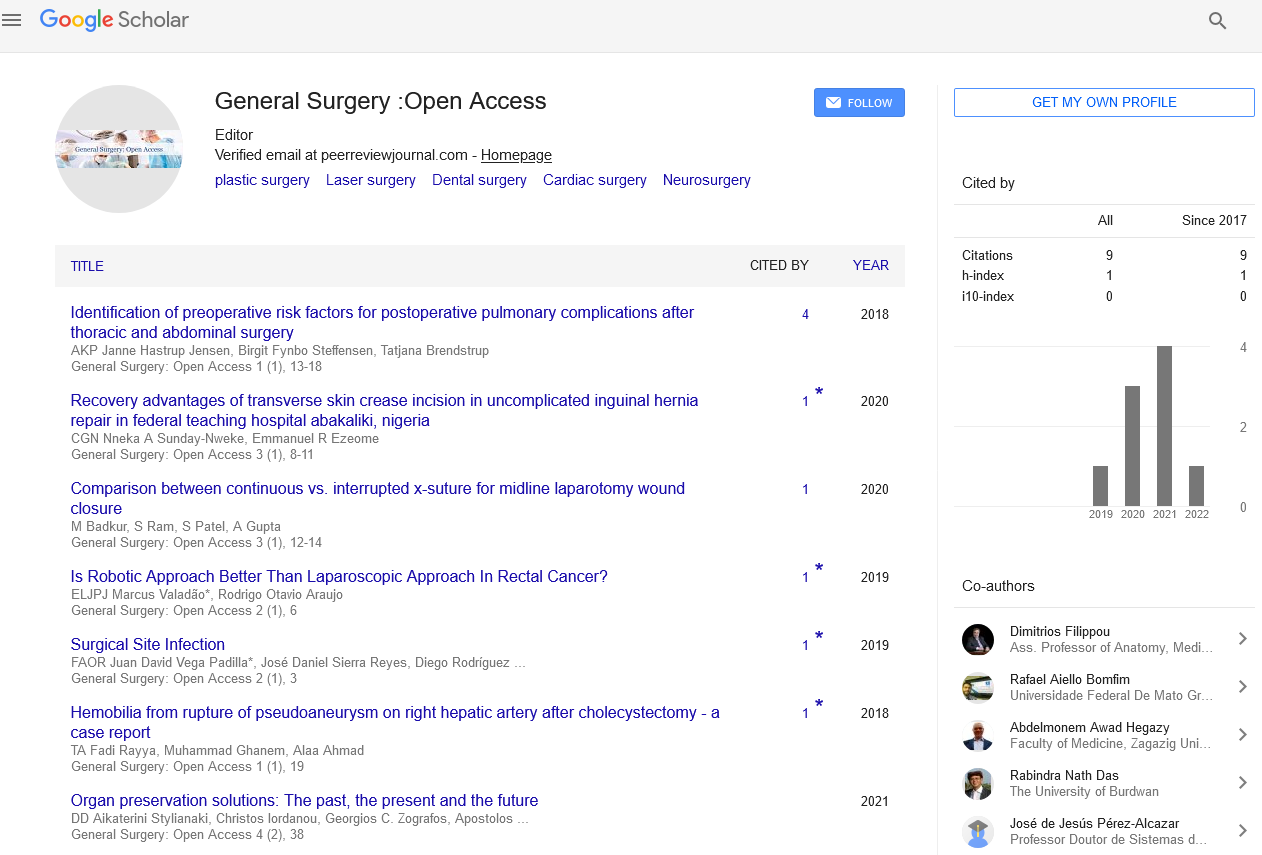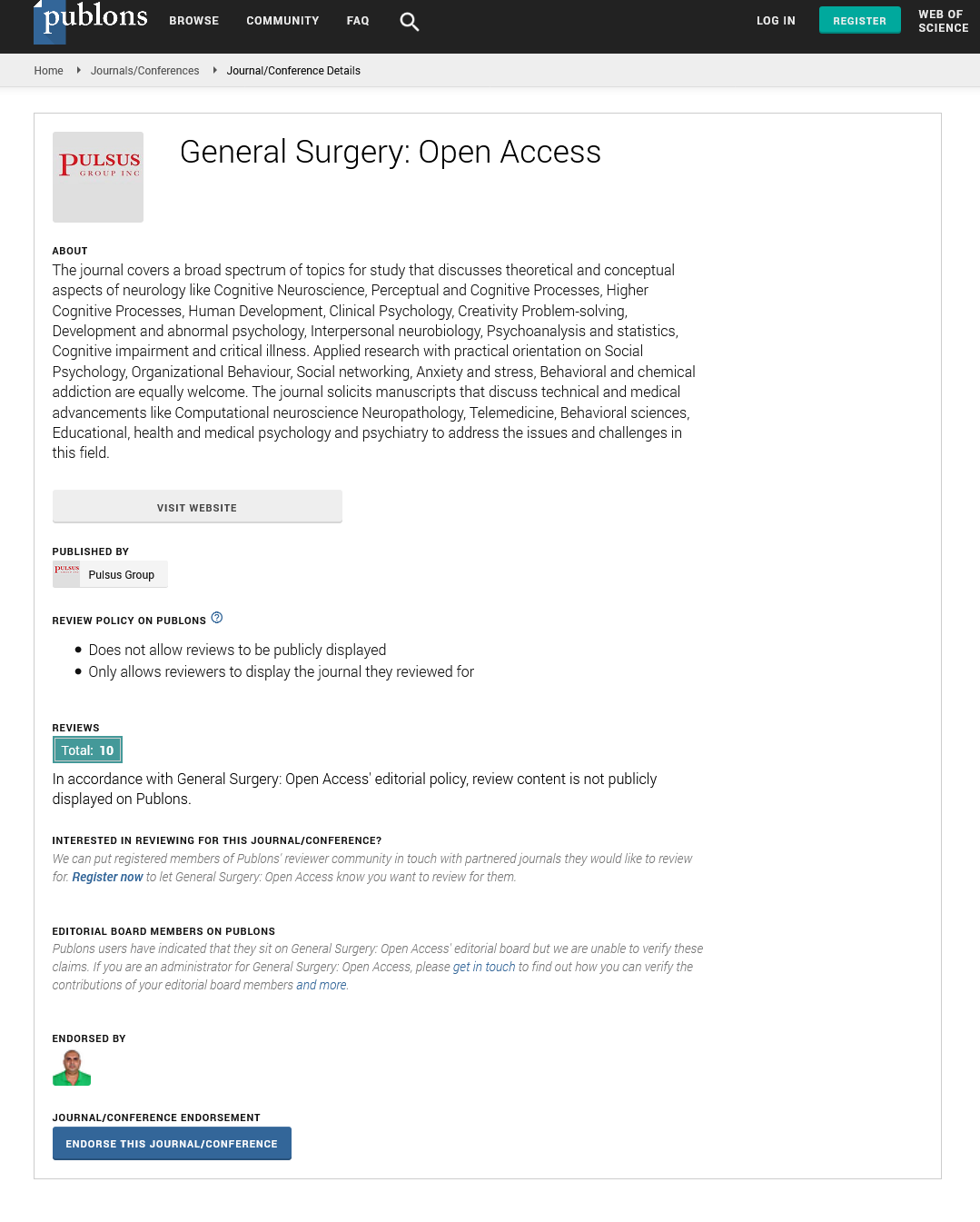Short note on acute aortic syndrome
Received: 03-Nov-2021 Accepted Date: Nov 17, 2021; Published: 24-Nov-2021
Citation: Ampar N. Short note on acute aortic syndrome. Gen Surg: Open Access. 2021;4(6):51.
This open-access article is distributed under the terms of the Creative Commons Attribution Non-Commercial License (CC BY-NC) (http://creativecommons.org/licenses/by-nc/4.0/), which permits reuse, distribution and reproduction of the article, provided that the original work is properly cited and the reuse is restricted to noncommercial purposes. For commercial reuse, contact reprints@pulsus.com
Description
Acute aortic syndrome is a modern term that includes aortic dissection, intramural hematoma (IMH), and symptomatic aortic ulcer. In the classical sense, acute aortic dissection requires tear in the intima of the aorta, often preceded by medial wall degeneration or cystic midline necrosis. Blood passes through the tear that separates the endometrium from the media or adventitia, creating a false lumen. Propagation of the dissection starts from the first tear with lateral branches to anterograde or retrograde, causing complications such as mal perfusion syndrome, tamponade, or aortic valve insufficiency.
In acute aortic syndrome, most of the important findings that affect initial management and prognosis are captured on CT and systematically when assessing postoperative success and complications at any time using the mnemonic dissection algorithm can be identified.
Acute aortic dissection is the prototype of acute aortic dissection (AAS), including intramural hematoma, localized intimal fissure, penetrating atherosclerosis, traumatic or paroxysmal aortic dissection, and leaky or ruptured aortic aneurysm. Symptoms are usually sudden and catastrophic, with acute severe chest or back pain. However, clinical symptoms cannot distinguish between the type of AAS and other acute pathological conditions. Diagnostic imaging is essential for the rapid identification and accurate diagnosis of AASs type, extent, and complications. Rapid CT acquisition of volume datasets is important for diagnostic, monitoring, and intervention planning. The most important findings regarding initial intervention and prognosis are CT including ascending aorta involvement, location of primary intimal laceration, rupture, perfusion failure, false lumen size and patency, anatomical complexity and extent, and maximum caliber. Aorta and complications after progression or intervention. Stanford type A ascending aortic lesions have the earliest fatal complications and require surgical intervention to control morbidity and mortality. Lesions without the involvement of the Stanford ascending aorta have a lower incidence of acute complications. During acute to longitudinal progression, a variety of specific and non-specific imaging findings occur, including pleural and pericardial effusion, fluid retention, progression including aortic enlargement, and postoperative changes seen on CT. Systematic analysis algorithms for CT of the entire aorta in the entire AASs continuum up to chronic and post-treatment conditions have been proposed, integrating key results and communicating them to all care providers.
Both acquired and hereditary disorders share a common pathway leading to disruption of endometrial integrity. Mechanisms that weaken the medial layer of the aorta ultimately lead to increased wall tension, which can lead to dilation of the aorta and formation of aneurysms, which can eventually lead to intramural hemorrhage, aortic dissection, or rupture. The factors that culminate in clinical anatomy are very different. The most common risk condition for aortic dissection is hypertension, which causes chronic intima thickening, fibrosis, calcification, and extracellular fatty acid deposition when the aorta is chronically exposed to high pressure [1-5].
Conclusion
In addition, the extracellular matrix can undergo elastic degradation with accelerated degradation, apoptosis, and final intimal destruction, most often at the edge of the plaque. Marfan syndrome, Ehlers-Danlos vascular syndrome, annuloaortic ectasia, bicuspid aortic valve, and familial aortic dissection are genetic conditions that often cause acute aortic syndrome. A common denominator of these various genetic disorders is similar pathophysiology, including dedifferentiation of vascular smooth muscle cells and increased elastic degradation of aortic wall components, resulting in intimal disorders and aortic dissection.
REFERENCES
- Yoo SM, Lee HY, White CS. MDCT evaluation of acute aortic syndrome. Thorac Surg Clin 2010;20(1): 65-149.
- Ahmad F, Cheshire N, Hamady M. Acute aortic syndrome: Pathology and therapeutic strategies. Postgrad Med J 2006;82(967):305-312.
- Vilacosta I, Aragoncillo P, Cañadas V, San Román JA, Ferreirós J, et al. Acute aortic syndrome: A new look at an old conundrum. Postgrad Med J 2010;86(1011):52-61.
- Evangelista A, Carro A, Moral S, Teixido-Tura G. Imaging modalities for the early diagnosis of acute aortic syndrome. Nat Rev Cardiol 2013;10(8):477-486.
- Nordon IM, Hinchliffe RJ, Loftus IM, Morgan RA, Thompson MM. Management of acute aortic syndrome and chronic aortic dissection. Cardiovasc Intervent Radiol 2011;34(5):890-902.






